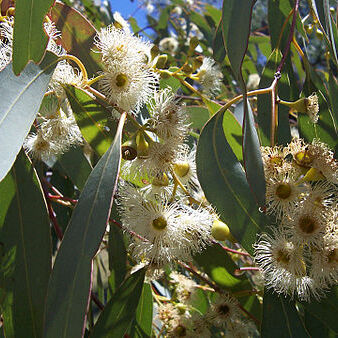Trees, shrubs or mallees. Bark smooth, fibrous, stringy or tessellated. Plants heterophyllous, i.e. seedling, juvenile, intermediate and adult phases occurring in most species, the latter phases sometimes not achieved; adult leaves glabrous, mostly alternate, usually petiolate, lanceolate, often falcate, pendulous, rarely erect, with a distinct midvein, penninerved or with parallel veins. Conflorescences usually of umbel-like condensed dichasia, usually pedunculate, single or rarely paired in leaf axils, or in terminal sometimes corymbose panicles; flowers 3 or more per umbel, rarely single, sessile or pedicellate; flowers sometimes male only. Calyx and corolla each or together forming an operculum that is shed at anthesis, the sepals sometimes free, falling separately or together. Stamens numerous, usually on a staminophore; anthers dehiscing by latrorse or introrse slits, or by confluent slits or by terminal pores; connective usually bearing a gland on back or at apex. Ovary 2–7-locular, inferior or partly superior; ovules many; ovulodes usually present. Fruit a capsule with a usually woody hypanthium, loculicidal, rarely circumscissile, with scars of operculum and staminophore at rim; disc convex, flat or descending; valves exserted, level with rim, or included. Seeds several to many, variously shaped and coloured.
Trees, shrubs or mallees, usually glabrous in adult stage. Lvs opposite for at least the first few pairs on juvenile plants, otherwise alternate, with aromatic oil glands. Fls in single or paired, axillary, usually pedunculate umbelliform cymes, or paniculate and terminal, or occasionally solitary. Bracteoles quickly caducous. Hypanthium wholly or partly enclosing ovary; sepals free or fused to form an operculum. Petals 5, always fused to form an operculum shed at anthesis. Stamens numerous, > petals, in 2 or more whorls, free or clustered into 4 groups; anthers versatile, dorsifixed or sub-basifixed and opening by discrete or confluent slits, or ± basifixed and opening by terminal pores; connective often prominent. Ovary 2-several-celled, surrounded by nectary disc; ovules numerous; style minute and inconspicuous or prominent. Fr. ± woody, composed of capsule and hypanthium, usually with loculicidal dehiscence, and teeth of valves included or exserted from hypanthium rim; viable seeds 2-c. 40.
Trees or shrubs with smooth to very rough bark of various types. Leaves usually markedly different in juvenile, intermediate and adult phases, the juveniles often opposite, cordate and sessile but adults mostly alternate, usually petiolate, falcate and pendulous. Flower usually in umbel-like condensed usually pedunculate dichasial cymes, either single or more rarely paired in the leaf-axils or in terminal corymbose panicles; flowers 3 or more per umbel or in a few species solitary, sessile or pedicellate. Calyx-limb and corolla each or together forming an operculum which is shed at anthesis but calyx-lobes sometimes free, falling separately or together. Stamens numerous; anthers dehiscing by pores or slits; connective mostly with a dorsal or terminal gland. Ovary 2–7-locular, inferior or partly superior; ovules numerous. Capsule usually woody, loculicidal or rarely circumscissile with scars left by falling operculum and androecium; disc convex or descending; valves included to exserted.
Fruit usually hard and woody, consisting of the more-or-less enlarged truncate receptacle-tube enclosing the capsule, which is always adnate to the receptacle-tube although often readily separable from it, opening by as many valves as there are locules.
Ovary inferior, 3–6-locular; placentation axile; ovules numerous in each locule; style subulate, rarely clavate, with a small truncate, capitate or rarely peltate stigma.
Receptacle-tube obconical, campanulate or oblong, adnate to the ovary, truncate and entire after the operculum has fallen or with 4 minute teeth.
Adult leaves sclerophyllous, mostly vertical, 2-facial, alternate, petiolate, usually elongate and narrowly lanceolate.
Perianth variously modified (see below) to form an operculum which falls off entire when the filaments expand.
Inflorescence fundamentally a dichasial cyme showing various degrees of expansion, aggregation or compaction.
Stamens numerous in several series, free or very rarely very shortly fused at the base into 4 clusters.
The unit inflorescence or “umbel” is in fact a condensed and usually partly reduced dichasium.
Juvenile leaves mostly horizontal, opposite, cordate and sessile.
Evergreen trees and shrubs.



